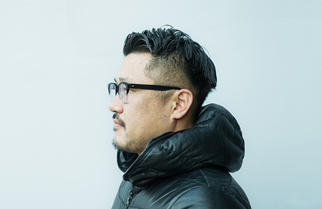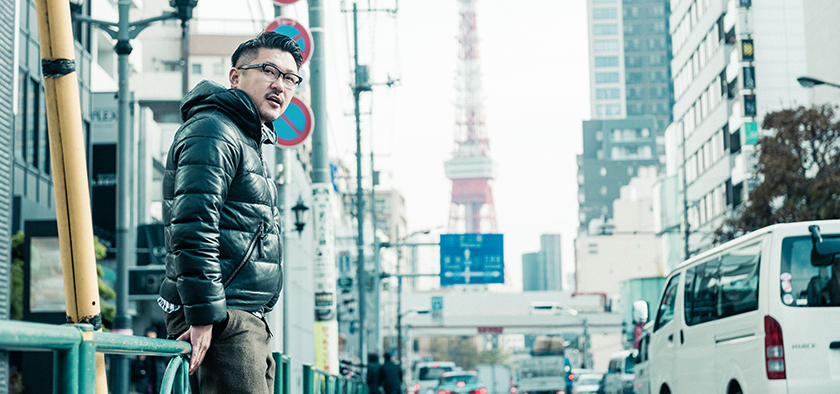
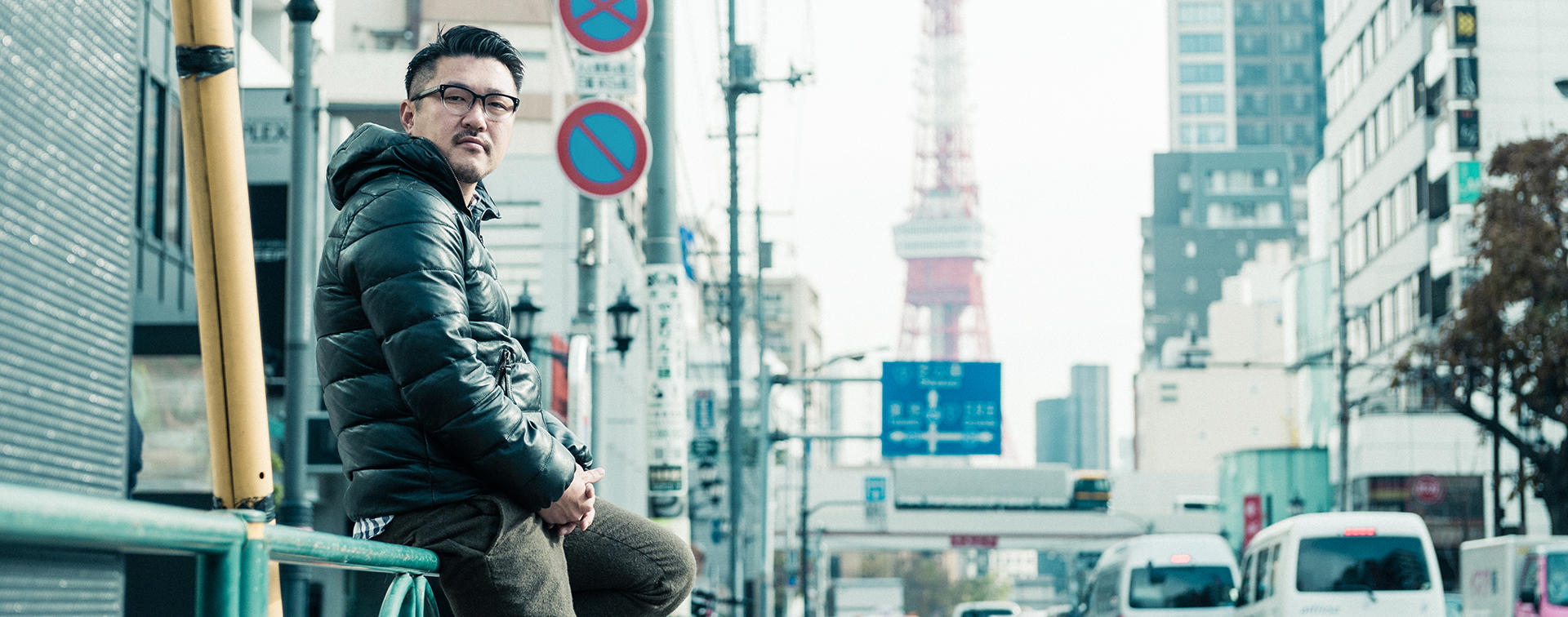
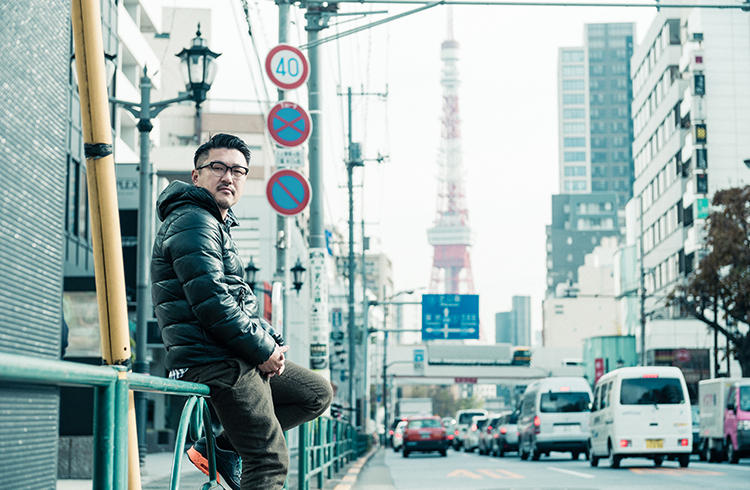
How steps taken now in Roppongi will be important for Tokyo in 2020
Organizing Roppongi Art Night with the Tokyo Olympics in mind
For our benchmark 50th "creator interview", we talked to Seiichi Saito, the head of design company Rhizomatiks, which has undertaken many innovative interactive works. Rhizomatiks has conceived experience-oriented events such as the memorable "FULL CONTROL TOKYO" where participants used au smart phones. Saito has been appointed media art director for "Roppongi Art Night 2015" to be held in April. He told us about the project he would like to do in Roppongi and then went on to talk about Roppongi Art Night and the Tokyo Olympics in 2020.
Reflecting on the legacy of the restaurant "Chianti"
I think it would be nice if we could reflect on the legacy of that famous restaurant "Chianti". I've been talking about this to a lot of people. I wish we could have a retrospective study of all the design and art and culture born from that establishment. That's probably the foremost project I would like to be doing right now.
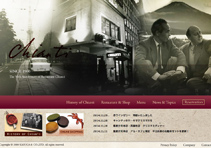
Chianti
The legendary Italian restaurant in Iigura Katamachi which was opened in 1960 by Hiroshi Kawazoe and his wife Kajiko. It quickly became a place of exchange for many cultural figures including writers, actors, musicians and designers. Its history has been documented in "Chianti Monogatari (The story of Chianti) published by Gentosha Bunko.
Of course, I know that a book on Chiant has already been published. And the other day, I saw a NHK TV program about Kajiko Kawazoe-san, the wife of the former Chianti owner, but all these are just fragments. I've heard stories from many senpai (seniors) in various fields about those days, but I feel there is a lot more to it. There are so many people I know who frequented that restaurant, and the total number of people who went there is huge: there must be all sorts of unknown stories that perhaps cannot be easily told.
Some of the older senpai who gathered at Chianti have retired or passed away, and we have little time left to make a movie, so we should do it now. Using film and words, I want to document what went on at that restaurant - what people talked about there. I want to sew all the fragments together.
A place where tiny cultural seeds can grow
Ever since a student, I've been coming to Roppongi to have fun. After Roppongi Hills and Tokyo Midtown were built, the place changed considerably, both in good and bad ways. I started my career as an artist, and from an artist's point of view, I think that with the National Art Center, Tokyo and Roppongi Art Night, the whole of Roppongi has become an area where it is easier to make artistic expressions. On the other hand though, there seem to be many things that have been lost.
Today, if someone were to ask, "Where shall we go to have fun?" there is no one place that everyone would suggest. There is no establishment where we can be sure to meet certain people. We don't have a special place like Chianti anymore; Chianti was a place you visited when you were dressed right and in the right mood and you felt up to it.
Roppongi is a place with restaurants like Chianti where all kinds of culture were born and are continuing to be born. Well, maybe it's not quite correct to say that culture is born here; it's more of an incubating place where tiny seeds for culture later grow into big things.
Using Roppongi Art Night as practice for the Olympics
To be honest, I neither like nor dislike Roppongi; it's been a place I come to when I had something to do. But now that I've come to be involved with Roppongi Art Night, I'm beginning to see that Roppongi has a lot of interesting things. These days, I often walk by myself in the streets and think "Hey, there's a parking lot here!" or "I wonder if the closing time for the garden at the back of Tokyo Midtown can be extended." I might also become imaginative and think, "Maybe it might not be possible to totally ban traffic at the Roppongi intersection, but perhaps the traffic could be stopped for just a little while" or "I wonder if we could link all the visuals in Roppongi and do something with them."
I'm hoping that Roppongi Art Night will become a street-linked event which everyone can participate in. That's because - and this is something that many other people are saying as well - the Tokyo Olympics in 2020 is on my mind. I feel that the Roppongi Art Night this year will be the first round of practice for the Olympics. I'm sure that the organizers of Roppongi Art Night and people at the Tokyo metropolitan government are currently taking steps with an eye to what can be done here in Tokyo ahead of the Olympics. I myself am wondering how we can attract people to participate in events; I want to experiment and see how people, including myself, can connect more with others.
I'm no longer interested in pursuing my own ideals, or in holding events similar to those overseas; all I'm thinking about now is what can realistically be done here. Of course there are restrictions such as the traffic laws and landscape regulations, and the people at the various facilities have their own thoughts. My role is to get people involved and make it an event for everyone in Roppongi. I strongly feel that we need to create a place where people can connect with each other in a genuine way.

Starting with the small and accessible things
My position at Roppongi Art Night is "media art director." The great thing about media art is that you can instantly connect using everyday devices like smart phones and tablets that are linked to the Internet. Until now, I've been using my smartphone simply because it's interesting, but I've recently realized that smartphones are already pieces of interactive artwork.
I was conscious of this fact doing the "FULL CONTROL TOKYO" event for au; Kyary Pamyu Pamyu did a live performance with Zojoji Temple and Tokyo Tower as the backdrop. That's the sort of thing that is simple, but pure fun. People remember such events much more vividly than they would a TV commercial. Contemporary art rarely offers that kind of experience. Contemporary art is a bit remote from everyday life, isn't it? Going to an art museum with your girlfriend and looking at art is a wonderful experience, but there's still a distance between the artworks and your actual self. I think media art is attracting attention recently because whether for good or bad, it can transcend the boundaries of genres such as design, art and advertising.
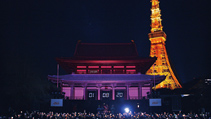
FULL CONTROL TOKYO
A participation-oriented concert held in January 2013 at Zojoji Temple as a promotion event for mobile phone company au's "4G LTE" service. Projection mapping was made on the walls of the temple's "honden" building, and the lights of the Tokyo Tower behind changed their colors. People participated in the concert using a mobile phone application especially designed for the event. The event was broadcast live on the Internet and the footage was used for au's TV commercials.
At last year's Roppongi Art Night, the theme was "Move Your Body!" but I think perhaps the general public found it a little difficult to suddenly start moving and dancing. Most of us don't know how to dance and we feel a bit embarrassed.
I often tell people that media art is like Doraemon's "Gulliver Tunnel." The entrance is small, but the tunnel gets bigger at the exit. You can attract people to art by starting with the small and accessible things. It's possible to do that with artistic expressions which incorporate technology. My hope is that by using digital devices, we can create a stronger sense of connection and sense of participation.
NHK's joyful "Nodo Jiman" program
I studied architecture, so I'm naturally interested in thinking of town-oriented projects. In another project for au, we once created a disco at the Shibuya scramble crossing. I'm very drawn to using the energy of the outdoors to show people that streets are actually very interesting. I've recently become involved in a project called "'West meets East' Sendai Subway Tozai Line _WE in Sendai" with Hima Furuta-san and others and we're starting to do things related to town-revitalization.
When I was working in the art world, I realized that the people an artist can make happy are basically limited to those who come within a distance of 2 meters or so of the artist. And the artist is basically interested in making only those people happy. But it would be better, don't you think, if artists could expand their influence to a larger area. There are situations where there are many people in the same place and everyone is feeling stirred and joyous. Festivals are such events, and so is the NHK Sunday afternoon program "Nodo Jiman" (Amateur Singing Contest). Everyone is so happy in that program. The presenter might say to a contestant, "I understand your father passed away last year," and the contestant smilingly replies, "Yes, that is so." And then the camera shows the contestant's family in the audience holding a picture of the deceased father, and it's amazing how there is an enveloping atmosphere of happiness.
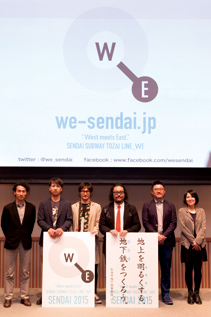
"West meets East" Sendai Subway Tozai Line _WE in Sendai
A citizen participation project aimed at improving Sendai in line with the construction of a new subway line. The project consists of "WE SCHOOL" where people can learn about revitalizing and developing Sendai, "WE STUDIO" where various plans are actually carried out and "WE TUBE" whereby digital signage will be set up at 13 subway stations.
When I watch programs like "Nodo Jiman" or visit festivals like the Nebuta festival, tears come to my eyes for some reason - maybe it's because I'm getting old. (laughs) I guess I'm moved by seeing all the people facing the same direction, looking at the same thing and feeling so happy.
Becoming personally involved with the Olympics
I think we need to create the same kind of atmosphere for the Olympics. People need to feel that they are part of it and that they are personally involved. Without participation, there will only be the sense that the Olympics is for other people and we will get disappointing results - in terms of economic effects as well. You can become personally involved in all kinds of ways - it doesn't have to be a grand thing. It can be things like brushing up your English conversation skills for all the visitors who will come from abroad, or making a menu in English, or if you have a restaurant on the street where the Olympic torch will pass through, you could think about putting up decorations or repainting the signboards or selling sausages in a stall at the parade.
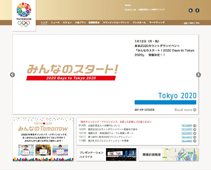
2020 Tokyo Olympics and Paralympics
Tokyo was chosen as host city for the 2020 Olympics and Paralympics at the IOC session in Buenos Aires in September 2013. Tokyo had promised to hold a compact and accessible Olympics. In 2020, the Olympics will be held July 24 (Fri) -Aug. 9 (Sun) and the Paralympics will be held Aug. 25 (Tue) - Sept.6 (Sun).
Just before the London Olympics started, I was in London doing an installation, and from what I heard, it got the impression that the mood wasn't all that festive. At the Tokyo Olympics, much of the sporting venues are apparently going to be concentrated within a radius of 8 kilometers from the Olympics Village, so I hope that within that area at least, there will always be an atmosphere of strong excitement. Not that I have been appointed to do anything for the Olympics. (laughs) But it would be a pity if people had so little interest that they don't even know the dates of the Olympics.
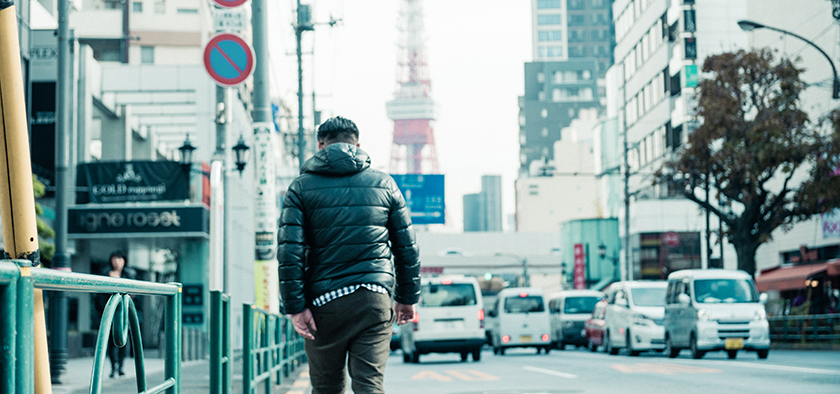
Cooperation between the public and private sectors
We've been participating every year at "MEDIA AMBITION TOKYO" held in February, a couple of months before Roppongi Art Night; it's an event created by private companies. It was set up as a sort of "shadow version" of the Japan Art Media Festival held during the same time. Works are exhibited, and there are parties and concerts where you can drink and meet people including people you would refer to as patrons. I personally feel that for the time being, we should not have the public sector involved in this event.
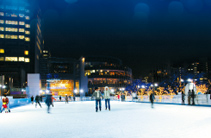
MEDIA AMBITION TOKYO
"MAT 2015", which will mark its third year, will be held Feb. 11(Wed) - 15 (Sun) 2015. At the "Diners Club Ice Rink in Tokyo Midtown", the biggest ice rink in Tokyo, an event dubbed "Skate Drawing Rhizomatiks Presented by Roppongi Future Talks" is scheduled to be held. This event will be the sixth project to originate from ideas given by creators who have been interviewed in the Roppongi Future Talks. Below are details on the idea realization project (Japanese version only)
http://6mirai.tokyo-midtown.com/event/project/06/
On the other hand, Roppongi Art Night is an event that would be impossible to hold without the participation of the public sector because it's an event that involves the streets and facilities of Roppongi. The good thing about Roppongi Art Night is that it's organized jointly by the public and private sectors. It's thanks to the smooth cooperation between the two that the event is becoming increasingly recognized.
In the past, I've only seen portions of Roppopngi Art Night and this seems to be the case with most people too. In the past, for example, I would go to a performance held by someone at Tokyo Midtown and then go to another event held in a different place. And in the time in between, I would go somewhere and have a drink. Ideally though, the visitors should stay at the venue of Roppongi Art Night the whole time, and not keep going out and coming back in. I'd like to make people feel that wherever they go, they will be able to have fun and connect with others.
Coming up with ideas for the streets of Tokyo
Of course when holding an event, there are all kinds of regulations to consider; some moves cannot be made because they are banned by transport laws or landscape regulations, and some places cannot be opened to the public for 24 hours. One regulation that still doesn't make sense to me - especially now when projection mapping has become so widespread - is the ban against projecting images on a building across a road. The apparent worry is that even if the images were to be projected at a level higher than the eye level of pedestrians or people in cars, they would be distracting and lead to accidents. Well, if it's about distraction, all the advertisements in the streets would have to be banned too...
It's the law, so it is impossible to persuade anyone by submitting written materials and making presentations. To gain understanding, all we can do is to take as many experimental steps as we can and provide the evidence that things can go right. I hope that by doing that at Roppongi Art Night, we will be able to prompt people to think about what kind of steps are safe, or what are too risky, and how certain problems can be solved. We're holding study sessions with people from the public sector and they are really working hard and doing such a lot. The other day, there was a Halloween parade in the Roppongi streets and I sensed that things are gradually changing.
I feel that now is the time for everyone to come up with ideas to utilize and improve the city of Tokyo, or else we won't be in time for the year 2020. It would be too late to start thinking about things in 2017 or 2018. If we want to hold a parade in "MacArthur Dori" and remove the median strip, or if we have to do something about the trees because we want to install illuminations, now is the time to start moving.
MacArthur Dori"(MacArthur Street)
A nickname given to a 1.4 km strip of the Kanjo Nigosen road connecting Shimbashi and Toranomon. The road was completed on March 29, 2014, 68 years after the initial plan. It consists of the "Tsukiji Toranomon" tunnel for automobiles and of the road above named "Shintora Dori".
Creating surprises that will have a good effect on towns
With Tokyo chosen as the host city and everyone starting to make preparations for the Olympics, I think the Roppongi Art Night this year is going to be a good case study. I hope that we can hold much deeper talks with the people in the Roppongi shopping district and at Roppongi Hills and Tokyo Midtown. If there are any regulations that get in the way of anything, I hope we can discuss them. I'm prepared to go anywhere and talk passionately for several hours if necessary. (laughs) I'm thinking of using up all my energy this year.
I think the element of surprise is important in our work. We should aim to use technology and devices in new ways that take people by surprise. All our work would just be a waste of time and money if we can only manage to get a tepid response from people. Surprise was an important factor when we planned the event using the Tokyo Tower and the Zojoji Temple, or held a corporate event at the National Museum of Emerging Science and Innovation in Odaiba, or planned a project ahead of the completion of the tunnel in Shintora Dori. I'm constantly thinking about how we can create surprises for people, and it's my hope that what we do will eventually have a good effect on towns.
Editor's thoughts
Saito-san told us that he is planning to move to Hayama in the near future. When we asked him why he said, "People need to both work and relax and I wanted to make an experiment. When you spend all your time in the city, you become desensitized to the chaos around you, so I thought it might be a good idea to look at the chaos from the outside and go into the city every day." Then he added laughingly, "Maybe I want to do this because of my age." I wonder what kind of ideas will come to Saito-san as he looks at Tokyo from the outside. I hope we will be able to talk to him again.(edit_kentaro inoue)




